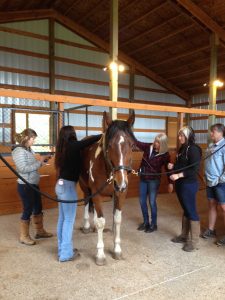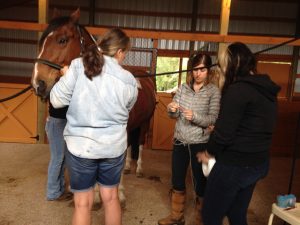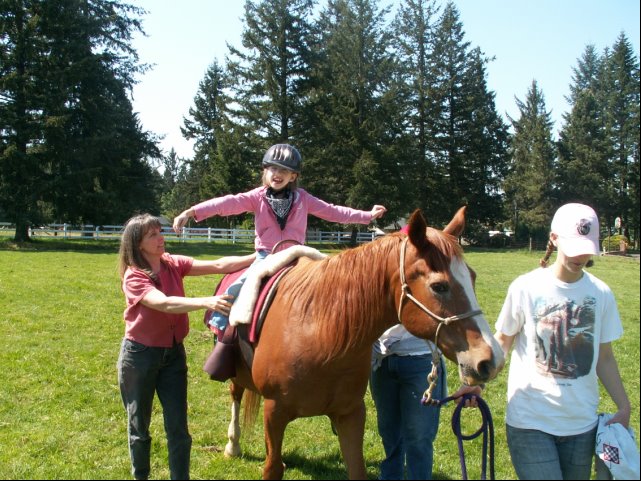Therapeutic Riding Centers: The Horses’s Perspective
I can’t tell you how many times I’ve heard the comment that I donated my horse to a therapeutic riding center and felt this was a win/win situation. They envision their horse with the simple job of packing around a disabled rider at the walk. This is a far harder job than most people realize.
The horse carrying a disabled or challenged rider is unbalanced dead weight that places a disproportionate amount of balancing for the horse to deal with. This causes many horses to become very sore. A sore horse can quickly become disgruntled. Nippy is often one of the first signs along with pinned back ears. Other problems that arise are head butting, tail swishing and even start to  buck and kick out. Boredom is another issue. Colic can increase from horses that internalize their stress. And particularly in all volunteer programs lack of consistency in horse handler relationships, feed, proper nutrition, lack of turnout and others show up as signs of neglect.
buck and kick out. Boredom is another issue. Colic can increase from horses that internalize their stress. And particularly in all volunteer programs lack of consistency in horse handler relationships, feed, proper nutrition, lack of turnout and others show up as signs of neglect.
I was reminded of this when in a recent microcurrent training the staff from a therapeutic riding center attended as a refresher course. The owner, Bobbi Culter a physical therapist is one that recognizes the importance of having horses that are happy and suited to the job. Part of the happiness means helping to keep their bodies comfortable. Bobbi understands that a regular schedule of body maintenance for the horses means that horses will last in her hippotherapy programs. Having staff perform the function of horse therapist creates a further bond that is deepened between equine stock and their handlers.
Since therapeutic programs often do not have a program for horse retraining the placement of
a sour horse is difficult.
Key points to look for before donating your horse to a hippotherapy program.
- Is it professional program with physical therapist’s on staff that are also experienced in horsemanship?
- Ratio of paid staff experienced in owning, maintaining and training horses and horses in the program vs volunteers.
- Facility: Ask about turnout, cleanliness, and length of time in business.
- Horses: How do they look? Are they happy? Good in bodyweight? Are feet kept up?
- Horses: Does anyone else work the horses for fitness?
The reality is that many hippotherapy programs depend on donations especially if they do not have a solid client payer income. Donations are often not sufficient to cover bodyworkers so they solicit volunteer bodyworkers. This is usually a hit or miss proposition and certainly not an ideal way to support the horses well being. Medications and supplements can certainly help with pain. Good physical therapy equipment options are the SoundWave Massager, Thermotex Infrared Blanket, Light Therapy (LED or Laser as a Class III or less), and MicroCurrent (microamperage) are examples of tools that not only help with soreness but act as preventive measures for longer careers. The therapy equipment mentioned are in affordable price ranges and can be acquired gradually.
 Horses are staff. Keeping staff happy is key to a long term successful program. The reward of a therapeutic sessions for the horses will make a huge difference in reduced turnover and operating costs
Horses are staff. Keeping staff happy is key to a long term successful program. The reward of a therapeutic sessions for the horses will make a huge difference in reduced turnover and operating costs
To voluteener or to learn more about therapeutic riding centers visit Path (Professional Association of Therapeutic Horsemanship International at www.pathintl.org. They have a links to find a center near you. And American Hippotherapy Association Inc. at http://www.americanhippotherapyassociation.org/. AHA has a link to US and International therapist’s. Also, North American Riding for the Handicapped Association (NARHA) //www.nchpad.org
A quick interenet search for your area is also a good way to find local centers to check out.
To learn more about the physical therapies mentioned read the book “MicroCurrent for Horses and other vital therapies you shoud know”

